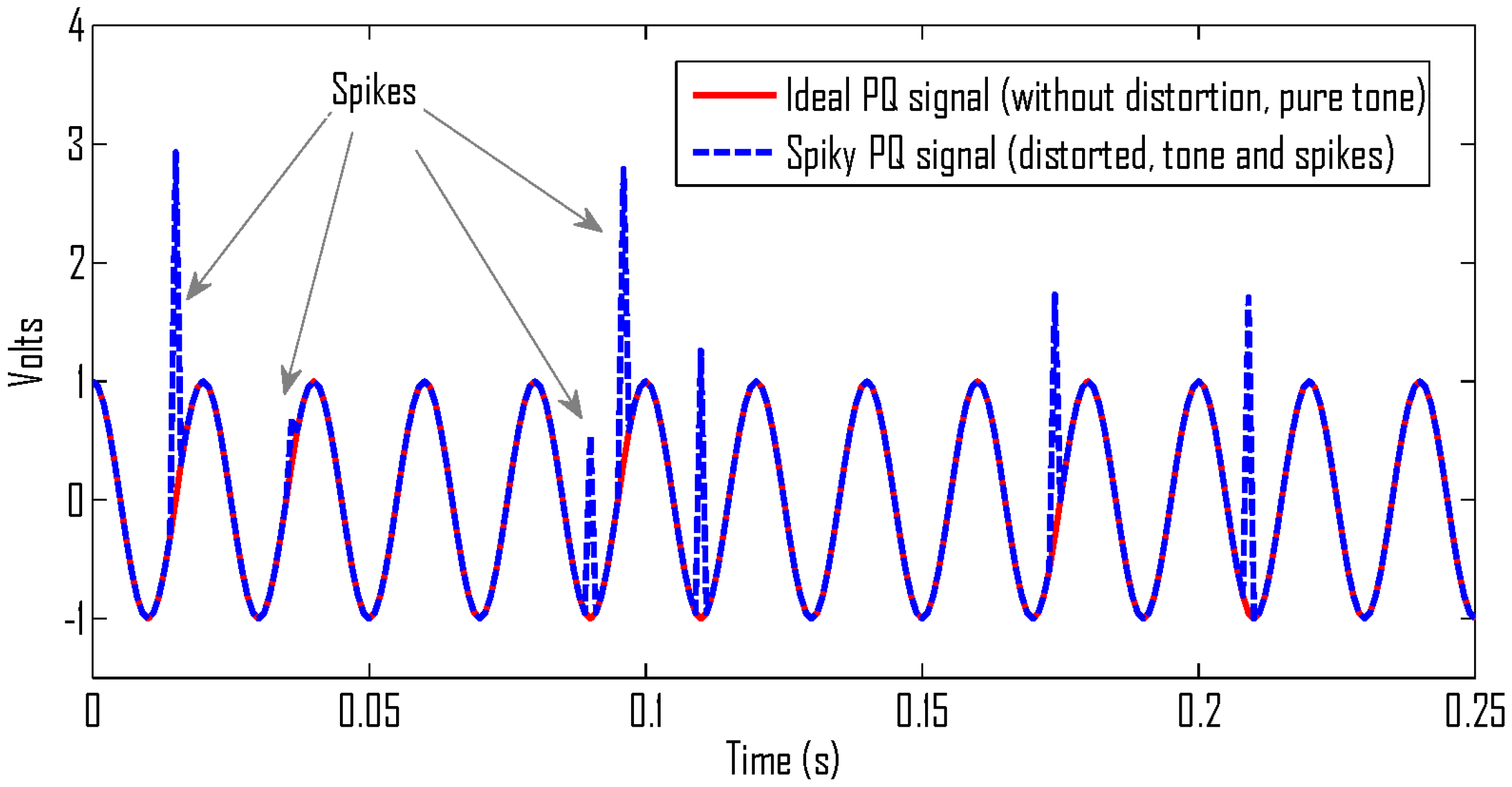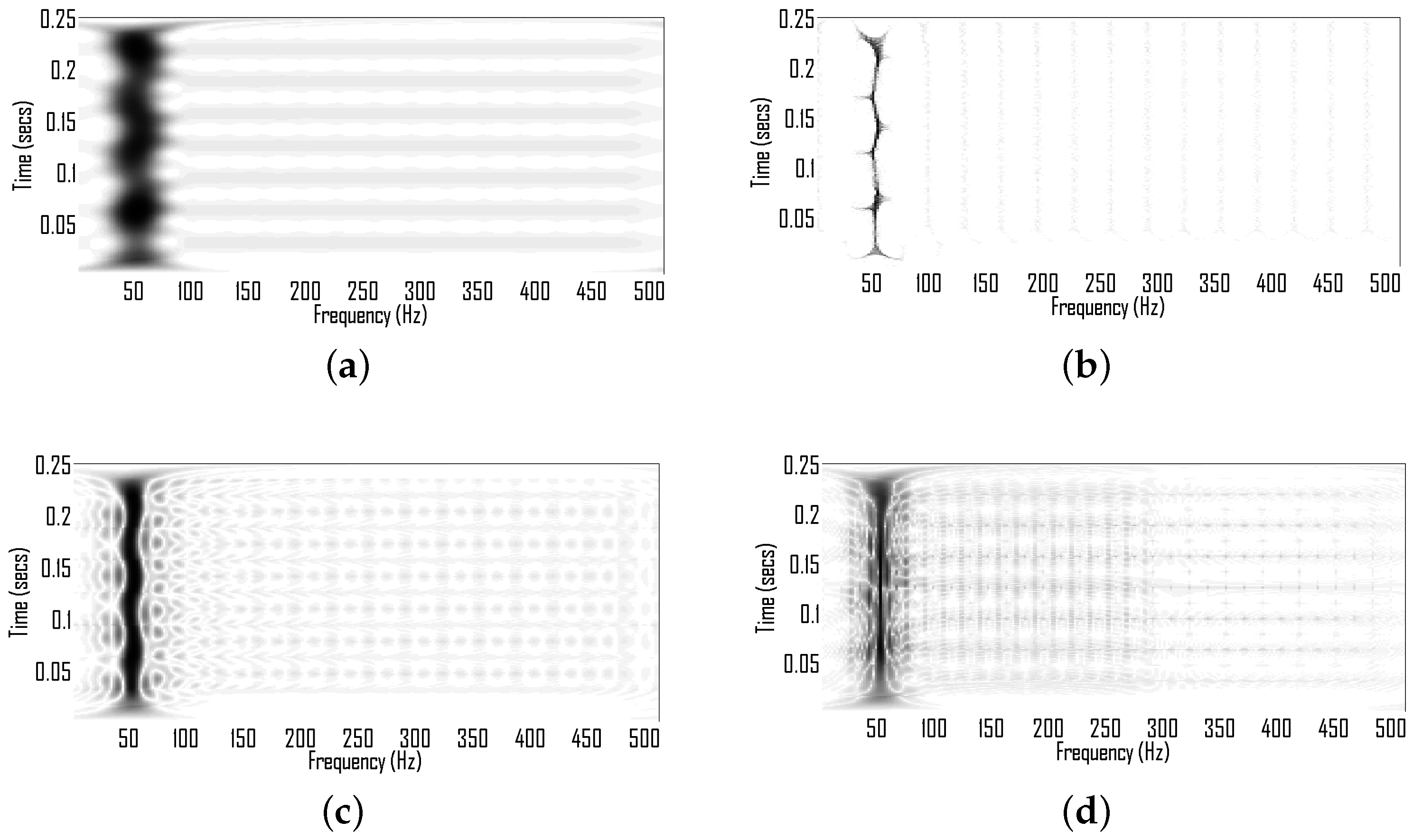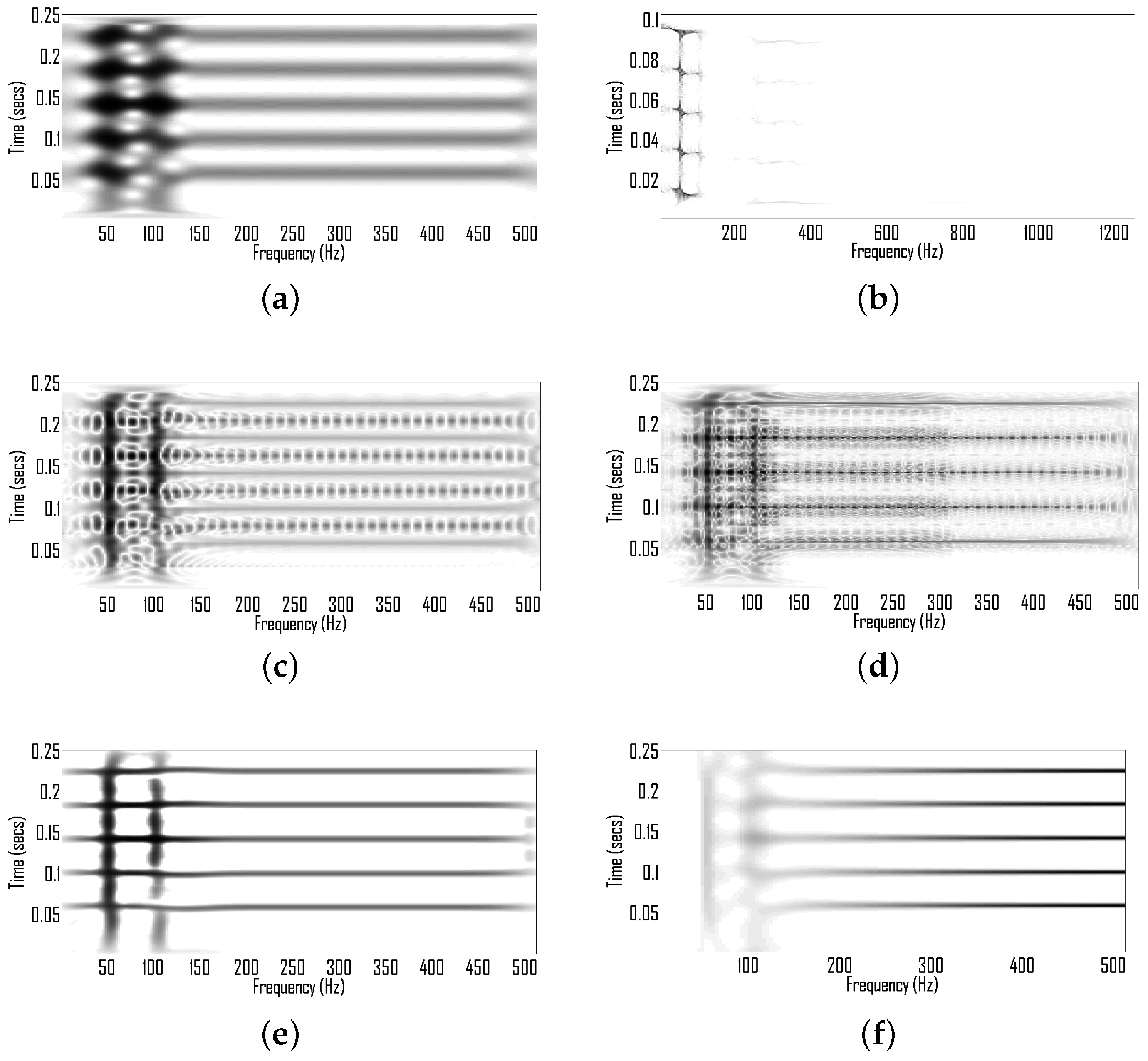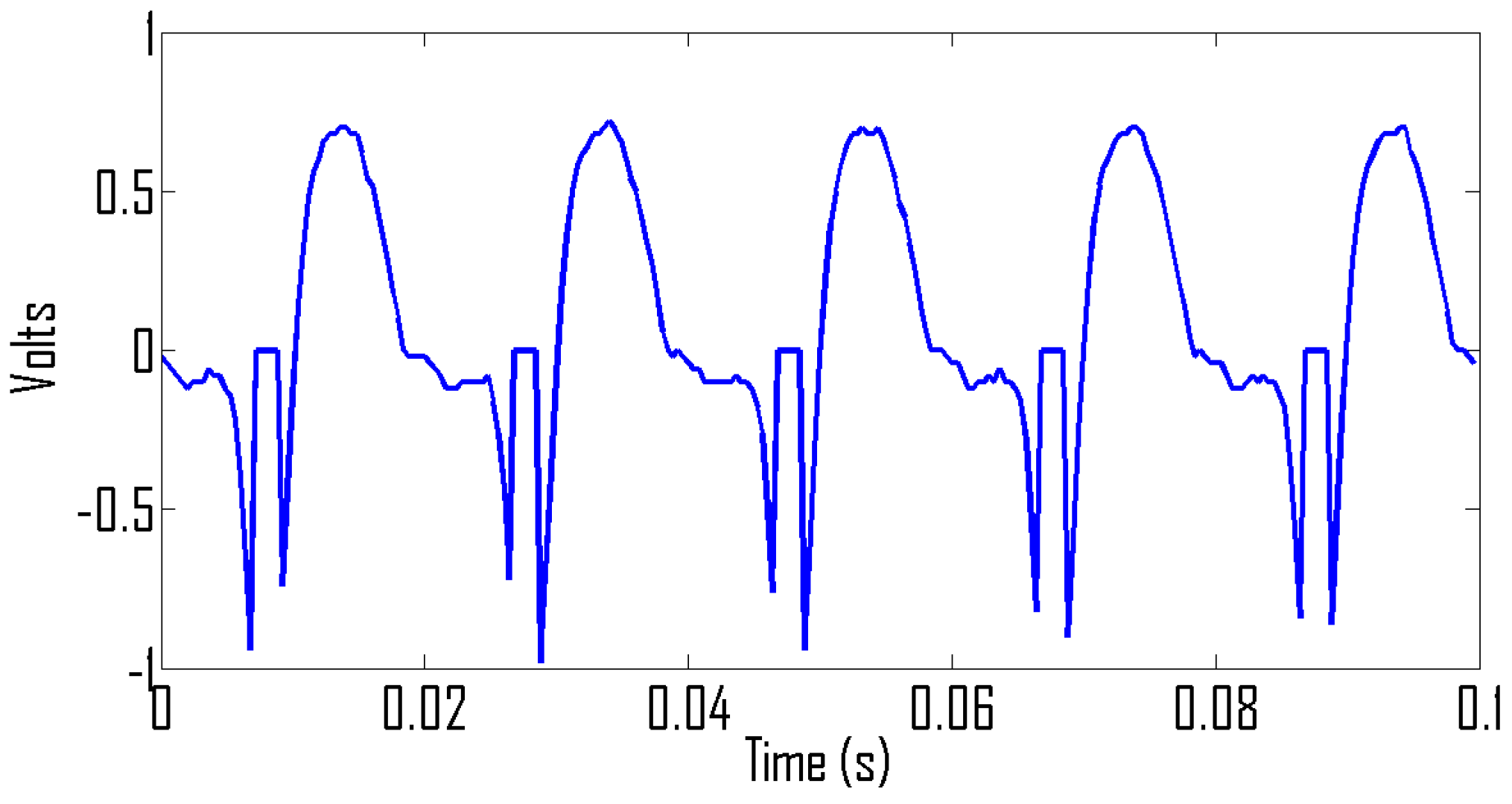Analysis of Power Quality Signals Using an Adaptive Time-Frequency Distribution
Abstract
:1. Introduction
2. Signal Model for Power Quality Signals
3. Review of Time-Frequency Distributions
3.1. Quadratic Time-Frequency Distributions
3.2. Linear Short Time Fourier Transform
3.3. Gabor Wigner Transform: A Combination of Linear and Quadratic Methods
4. Proposed Methodology
4.1. Adaptive TFD for PQ Signals
- Cross-terms appear as ridges in the joint TF domain with their major axis being parallel to the direction of their oscillation [12].
- The direction of cross-terms’ oscillation, caused by the interaction of tones (fundamental frequency) and harmonics, is parallel to the time axis.
- The direction of cross-terms’ oscillation, caused by the interaction of spikes, is parallel to the frequency axis.
- It has a low pass characteristic response when it is aligned parallel to ridges, that is, along the major axis of auto- or cross-terms. This low pass characteristic results in the reduction of cross-terms and signal to noise ratio enhancement of auto-terms.
- The response of this kernel becomes zero when it becomes orthogonal to the major axis of auto-terms. This characteristic of the smoothing kernel avoids the spreading of signal energy for TF points where no signal is present.
4.2. Feature Extraction Using the Adaptive TFD
5. Numerical Analysis
5.1. Synthetic Signals
5.2. Real World Signals
6. Conclusions
Acknowledgments
Author Contributions
Conflicts of Interest
References
- Biswal, B.; Biswal, M.; Mishra, S.; Jalaja, R. Automatic classification of power quality events using balanced neural tree. IEEE Trans. Ind. Electron. 2014, 61, 521–530. [Google Scholar] [CrossRef]
- Faisal, M.; Mohamed, A.; Shareef, H.; Hussain, A. Power quality diagnosis using time frequency analysis and rule based techniques. Expert Syst. Appl. 2011, 38, 12592–12598. [Google Scholar] [CrossRef]
- Valtierra-Rodriguez, M.; de Jesus Romero-Troncoso, R.; Osornio-Rios, R.A.; Garcia-Perez, A. Detection and classification of single and combined power quality disturbances using neural networks. IEEE Trans. Ind. Electron. 2014, 61, 2473–2482. [Google Scholar] [CrossRef]
- Avdakovic, S.; Bosovic, A.; Hasanspahic, N.; Saric, K. Time-frequency analyses of disturbances in power distribution systems. Eng. Rev. 2014, 34, 175–180. [Google Scholar]
- Khadse, C.B.; Chaudhari, M.A.; Borghate, V.B. Conjugate gradient back-propagation based artificial neural network for real time power quality assessment. Int. J. Electr. Power Energy Syst. 2016, 82, 197–206. [Google Scholar] [CrossRef]
- Hajian, M.; Foroud, A.A.; Abdoos, A.A. New automated power quality recognition system for online/offline monitoring. Neurocomputing 2014, 128, 389–406. [Google Scholar] [CrossRef]
- Hajian, M.; Foroud, A.A. A new hybrid pattern recognition scheme for automatic discrimination of power quality disturbances. Measurement 2014, 51, 265–280. [Google Scholar] [CrossRef]
- Szmajda, M.; Górecki, K.; Mroczka, J. Gabor transform, spwvd, gabor-wigner transform and wavelet transform-tools for power quality monitoring. Metrol. Meas. Syst. 2010, 17, 383–396. [Google Scholar] [CrossRef]
- Huang, N.; Lu, G.; Cai, G.; Xu, D.; Xu, J.; Li, F.; Zhang, L. Feature Selection of Power Quality Disturbance Signals with an Entropy-Importance-Based Random Forest. Entropy 2016, 18, 44. [Google Scholar] [CrossRef]
- Hlawatsch, F.; Boudreaux-Bartels, G.F. Linear and quadratic time-frequency signal representations. IEEE Signal Process. Mag. 1992, 9, 21–67. [Google Scholar] [CrossRef]
- Hlawatsch, F. Interference terms in the Wigner distribution. Digit. Signal Process. 1984, 84, 363–367. [Google Scholar]
- Boashash, B.; Khan, N.A.; Ben-Jabeur, T. Time–frequency features for pattern recognition using high-resolution TFDs: A tutorial review. Digit. Signal Process. 2015, 40, 1–30. [Google Scholar] [CrossRef]
- Pei, S.C.; Ding, J.J. Relations between Gabor transforms and fractional Fourier transforms and their applications for signal processing. IEEE Trans. Signal Process. 2007, 55, 4839–4850. [Google Scholar] [CrossRef]
- Kalyuzhny, A.; Zissu, S.; Shein, D. Analytical study of voltage magnification transients due to capacitor switching. IEEE Trans. Power Deliv. 2009, 24, 797–805. [Google Scholar] [CrossRef]
- Sumner, M.; Abusorrah, A.; Thomas, D.; Zanchetta, P. Real Time Parameter Estimation for Power Quality Control and Intelligent Protection of Grid-Connected Power Electronic Converters. IEEE Trans. Smart Grid 2014, 5, 1602–1607. [Google Scholar] [CrossRef]
- Memon, A.P.; Uqaili, M.A.; Memon, Z.A.; Adil, W.; Keerio, M.U. Classification Analysis of Power System Transient Disturbances with Software Concepts. Sci. Int. 2014, 26, 1447–1456. [Google Scholar]
- He, S.; Li, K.; Zhang, M. A New Transient Power Quality Disturbances Detection Using Strong Trace Filter. IEEE Trans. Instrum. Meas. 2014, 63, 2863–2871. [Google Scholar] [CrossRef]
- Liu, Z.; Cui, Y.; Li, W. Combined power quality disturbances recognition using wavelet packet entropies and S-transform. Entropy 2015, 17, 5811–5828. [Google Scholar] [CrossRef]
- Dash, P.; Panigrahi, B.; Panda, G. Power quality analysis using S-transform. IEEE Trans. Power Deliv. 2003, 18, 406–411. [Google Scholar] [CrossRef]
- Lee, I.W.; Dash, P.K. S-transform-based intelligent system for classification of power quality disturbance signals. IEEE Trans. Ind. Electron. 2003, 50, 800–805. [Google Scholar] [CrossRef]
- Laila, D.S.; Messina, A.R.; Pal, B.C. A refined Hilbert–Huang transform with applications to interarea oscillation monitoring. IEEE Trans. Power Syst. 2009, 24, 610–620. [Google Scholar] [CrossRef] [Green Version]
- Huang, N.E.; Shen, Z.; Long, S.R.; Wu, M.C.; Shih, H.H.; Zheng, Q.; Yen, N.C.; Tung, C.C.; Liu, H.H. The Empirical Mode Decomposition and the Hilbert Spectrum for Nonlinear and Non-Stationary Time Series Analysis. R. Soc. 1998, 454, 903–995. [Google Scholar] [CrossRef]
- Mohammadi, M.; Pouyan, A.A.; Khan, N.A. A highly adaptive directional time–frequency distribution. Signal Image Video Process. 2016, 10, 1369–1376. [Google Scholar] [CrossRef]
- Khan, N.A.; Boashash, B. Multi-component instantaneous frequency estimation using locally adaptive directional time frequency distributions. Int. J. Adapt. Control Signal Process. 2016, 30, 429–442. [Google Scholar] [CrossRef]
- Khan, N.A.; Ali, S.; Jansson, M. Direction of arrival estimation using adaptive directional time-frequency distributions. Multidimens. Syst. Signal Process. 2016, in press. [Google Scholar]
- Khan, N.A.; Ali, S. Classification of EEG Signals Using Adaptive Time-Frequency Distributions. Metrol. Meas. Syst. 2016, 23, 251–260. [Google Scholar] [CrossRef]
- Cho, S.H.; Jang, G.; Kwon, S.H. Time-frequency analysis of power-quality disturbances via the Gabor–Wigner transform. IEEE Trans. Power Deliv. 2010, 25, 494–499. [Google Scholar]
- Khan, N.A.; Jaffri, M.N.; Shah, S.I. Modified Gabor Wigner transform for crisp time frequency representation. In Proceedings of the IEEE International Conference on Signal Acquisition and Processing, Kuala Lumpur, Malaysia, 3–5 April 2009; pp. 119–122.
- Ajab, M.; Taj, I.A.; Khan, N.A. Comparative analysis of variants of Gabor-Wigner transform for cross-term reduction. Metrol. Meas. Syst. 2012, 19, 499–508. [Google Scholar]
- Bastiaans, M.J.; Alieva, T.; Stankovic, L. On rotated time-frequency kernels. IEEE Signal Process. Lett. 2002, 9, 378–381. [Google Scholar] [CrossRef]
- Auger, F.; Flandrin, P. Improving the readability of time-frequency and time-scale representations by the reassignment method. IEEE Trans. Signal Process. 1995, 43, 1068–1089. [Google Scholar] [CrossRef]










© 2016 by the authors; licensee MDPI, Basel, Switzerland. This article is an open access article distributed under the terms and conditions of the Creative Commons Attribution (CC-BY) license (http://creativecommons.org/licenses/by/4.0/).
Share and Cite
Khan, N.A.; Baig, F.; Nawaz, S.J.; Ur Rehman, N.; Sharma, S.K. Analysis of Power Quality Signals Using an Adaptive Time-Frequency Distribution. Energies 2016, 9, 933. https://doi.org/10.3390/en9110933
Khan NA, Baig F, Nawaz SJ, Ur Rehman N, Sharma SK. Analysis of Power Quality Signals Using an Adaptive Time-Frequency Distribution. Energies. 2016; 9(11):933. https://doi.org/10.3390/en9110933
Chicago/Turabian StyleKhan, Nabeel A., Faisal Baig, Syed Junaid Nawaz, Naveed Ur Rehman, and Shree K. Sharma. 2016. "Analysis of Power Quality Signals Using an Adaptive Time-Frequency Distribution" Energies 9, no. 11: 933. https://doi.org/10.3390/en9110933






